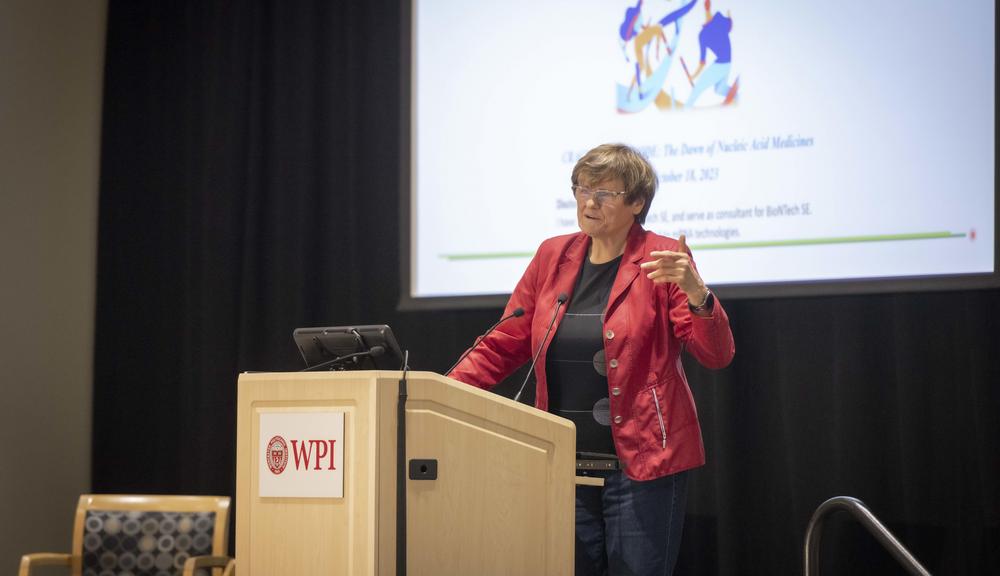
In the early 1990s, when the scientific community seemed skeptical of her belief that using the body’s messenger RNA, or mRNA, to develop therapies to fight disease and treat conditions was a real possibility, Katalin Karikó turned to her own family for validation.
The biochemist and recently minted Nobel laureate relayed to a packed audience last week at WPI’s Rubin Campus Center a story about trying to convince her husband, an engineer, and her 11-year-old daughter that mRNA would be the future of medicine.
She must have received the confidence boost she sought from that living room pitch—the Hungarian-born researcher’s belief that the tiny strands of life’s building blocks could one day be used to treat illnesses and vaccinate people from disease proved more than prescient.
Karikó was on the WPI campus as a keynote speaker at the Nature conference, a three-day event run by the family of prestigious scientific journals that drew scientists and researchers from around the world. Students and conference attendees crowded around her before her address, posing for selfies and getting her to sign copies of her book, Breaking Through.
Karikó and her colleague Drew Weissman—who met by chance while waiting to use a photocopier one day at the University of Pennsylvania–earlier this month received the Nobel Prize in Physiology or Medicine for their discoveries about how mRNA interacts with our immune systems. Their groundbreaking discoveries laid the foundation for rapid development of COVID-19 vaccines that saved countless lives and helped the world recover from a global pandemic.
While walking the conference audience through the dense science that has helped make mRNA therapeutics a reality in modern medicine, Karikó weaved into her remarks very personal elements of an unconventional career timeline marked by frequent rejection, constant struggle, and unwavering persistence that she hopes inspires the next generation of scientists.
She talked about how early proposals she crafted to look deeper into mRNA–the delivery system for genetic information encoded in DNA that leads to the production of proteins–went unfunded, and about how, very early, on she carried out the bulk of her research on her own, without an army of graduate and PhD students to help.
“I did the experiments,” Karikó said. “I know what it takes.”
Karikó said she didn’t hold any grudges for having to wait for others to come around to her vision of how mRNA could be used as a therapeutic. Years of rejection didn’t shake her confidence.
“It always made me work better,” she said. “That’s why I’m here.”
Karikó wasn’t the only Nobel laureate in attendance at the conference. Phillip Sharp, who won the prize in 1993 for co-discovering RNA splicing, spoke at the conference about the promise of RNA therapies for treating various conditions.
1993 Nobel Prize winner Phillip Sharp
Sharp and Karikó were among more than two dozen speakers who shared insights during the conference including WPI’s own Dmitry Korkin, the Harold L. Jurist ’61 and Heather E. Jurist Dean’s Professor of Computer Science. Korkin’s presentation was on decoding the functional and structural impact of alternative splicing in human cells.
The work being done on mRNA therapeutics is important for global health, but it’s also becoming an economic engine in Massachusetts. Melissa Moore, chief scientific officer emeritus at Moderna, worked closely with Jean King, the Peterson Family Dean of Arts and Sciences at WPI, to bring the conference here. Moore said 750 biotech or bio-manufacturing companies are currently operating in the state, and they offer good-paying jobs that cater to a wide variety of skillsets.
King said bringing the Nature conference to WPI highlighted the university’s strengths in the life sciences and reflected the sector’s widening footprint in Central Mass.
“The Nature conference at WPI brought some of the most brilliant minds in the world under one roof for three days to share insights, engage with students, and to find out what the future holds for nucleic acid medicine,” she said. “Having two Nobel laureates at the conference speaks to the intense interest in mRNA therapeutics and other cutting-edge approaches, but it also highlights the role this sector plays in the regional economy and at institutions like WPI.”
WPI and local high school students got the chance to rub elbows with researchers and scientists from private industry and academia during the conference. Around 170 city high school students attended a career day, where they learned more about current research and career opportunities with representatives from Alnylam, MassBio, Moderna, UMass Chan Medical School, and others.
Moore said it’s important to show students interested in STEM that there may be a career for them in biotech, regardless of where they’re coming from.
